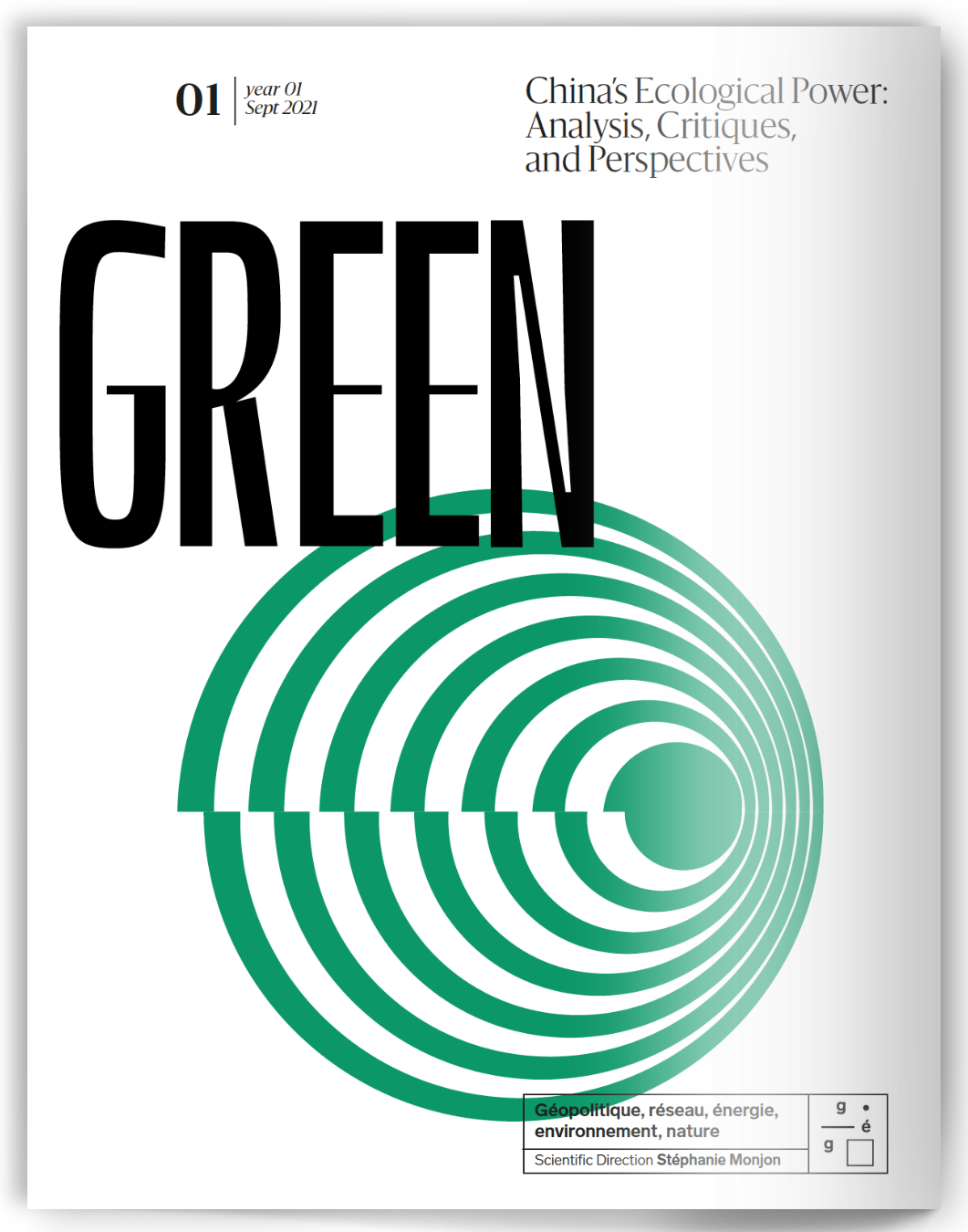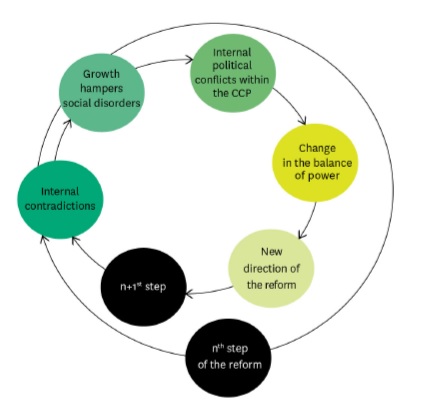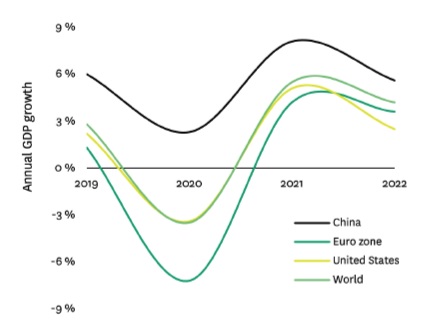The 14th Five Year Plan in the New Phase of Chinese Reform

Michel Aglietta
French economist, member of the Institut Universitaire de FranceIssue
Issue #1Auteurs
Michel Aglietta
21x29,7cm - 153 pages Issue #1, September 2021
China’s Ecological Power: Analysis, Critiques, and Perspectives
With its Hellenistic origins, western political philosophy claims to hold universal values that must be disseminated to the rest of the world in order to achieve an ideal state. This is why the American political scientist Francis Fukuyama believed that the end of History was approaching after the fall of the USSR 1 .
This philosophical tradition is foreign to Chinese thinking. It does not recognize an ideal nature, nor the transparency of a transcendent need-to-be. It is a thought of movement; of silent, global, and continuous transformation: the Tao. The Tao’s unity is the harmony of nature and society’s transformation. Harmony does not mean an ideal state, but a renewal of the contradictions that constitute the movement.
According to philosopher François Jullien, only a patient dialogue between cultures can lead to recognizing the common features of human well-being. On the contrary, by describing China as a strategic rival in the face of the 21st century’s global challenges — namely the Earth system’s limits in the face of capitalist ambitions of unlimited growth — Western political elites are steering away from taking collective responsibility for the planet’s shared resources.
Social structure and political order: from these, the rationale for reform is drawn.
In China, as in the Western world, it is recognised that the people are sovereign. But the term “democracy” means that the people (demos) have power over themselves (kratos). It is self-referential. In its etymology, democracy does not incorporate any ethical values. How is the wielding of power legitimate? The Western solution is procedural; it consists in representation through the electoral process. The Chinese conception is that of finality: has government been for the greater good of the people? The unitary sovereignty of the Empire must capture the unity of society’s movement. According to Mencius, a disciple of Confucius, the people confer legitimacy on political power if it is worthy of the mandate it has been given. To govern is to show the way of the Tao, by which the unitary sovereignty of the Empire grasps the unity of society’s movement. If this is not the case, the people can depose the power. Legitimacy is therefore that of the realisation of societal well-being.
As we have shown in a previous book, the People’s Republic under the leadership of the Chinese Communist Party (CCP) has recreated the Empire, which is to say the political order consisting of the verticality of power on the one hand, and the horizontality and autonomy of civil society on the other 2 . What is fundamental is that the collective comes first. It is the foundation of human meaning (“ren”) which is the moral connection and an integral part of the Tao. Civil society is a system of reciprocal relationship networks (the “Guanxi”) that are built over time in the form of mutual moral debts that establish trust, and of which the family is the foundation.
The rationale of Chinese reform contributes to this political order as a transformational phase which is included in the CCP’s mission to undo the century of humiliations suffered by the Chinese people (1840-1945) and thus to restore the Middle Kingdom in its abundance for the centenary of the People’s Republic.
Figure 1 • Path of reform

In accordance with the movement’s philosophy, this reform is comprehensive, pluralistic, gradual, and is nourished by its contradictions. Social tensions are produced by the erosion of harmony through the accumulation of uncompensated contradictions. These tensions generate crucial transitions which separate distinct phases. Reform does not refer to any ideal model: the purpose is in the path. Its rationale can be represented by the diagram in Figure 1.
The two completed phases of reform before entering the new era
The first phase was that of the agricultural revolution and corporate responsibility (1978-1993). It is a twin path of commercialized farm surpluses and the introduction of corporate responsibility. This resulted in a rapid growth of agricultural revenue. But tensions arose from the lack of separation between the financial system and the public administration along with the collusion between local governments and state-owned enterprises (SOEs). An explosion of credit and non-performing loans led to runaway inflation that massively depressed real wages in the late 1980s and brought about the events at Tiananmen.
The second phase (1994-2012) began with large-scale transformation from 1994 onwards: creation of the central bank, centralisation of fiscal resources, international outreach with entry into the WTO and direct foreign investment, resolution of the debt overhang and privatisation of businesses. China also began to revolutionise the international division of labour as the “the world’s factory”. Tensions returned in 2008 with the great global financial crisis and the gigantic stimulus package to avert it: high energy intensity, environmental degradation, overcapacity and the return of over-indebtedness in heavy industries, increased inequality between cities and the countryside and between provinces, massive and widespread corruption.
The return of socio-political tensions prompted the Party’s leadership change in 2013 and the move towards a radical change in the growth model, known as the New Era.
The New Era and its long-term objectives
The New Era extends to the year 2035 when the socialist market economy will be realized. This is the first step towards a harmonious society. Three political conditions for a harmonious society were established: no organised political force should oppose the State Party; the interests of the bureaucracy should be aligned with those of the sovereign people; the welfare of the people should be developed across generations.
This resulted in the priorities of the reform’s third phase:
- Inclusive policies: “all under heaven” according to the Confucian principle of “ren” (the human dimension). In order to respect institutions, all citizens must have a common interest in them.
- Balance with nature: the ecological footprint must respect the Earth system’s limits; this implies the restoring of natural resources and reestablishing the regulation capacity of ecosystems. Therefore, ecological policy must be the guiding principle for technological innovations in order to achieve the Sustainable Development Goals set out by the United Nations.
- Global balance: develop the pharaonic “New Silk Road” project (Belt and Road Initiative, BRI) to encourage countries to cooperate for mutual benefits, leading to international regimes of mutually-agreed rules. This alone will make it possible to build planetary common goods within the Earth system’s limits.
The quantitative focus of GDP is no longer relevant for qualitative growth. The United Nations’ Inclusive Wealth Index (IWI) is the composite indicator, which combines productive capital, human capital and natural capital weighed by countable indices which approximate the marginal social productivities of these three types of capital. An equivalence theorem shows that maximising inclusive wealth is equivalent to maximising the social welfare of a community 3 . However, UNEP’s measurement of IWI has shown that, in the great growth phase from 1990 to 2008, China was the country where IWI progressed the most among advanced and large emerging countries in terms of IWI per capita (average annual growth per capita of 2.1% over 1990-2008), mainly due to the massive reduction of poverty, whereas the average annual growth of GDP per capita was 9.6%. The two indicators are therefore not of the same nature. Moreover, one is a stock, a wealth, and the other a flow.
It can be concluded that the economic growth of a nation is sustainable over a long period when the variation of its IWI per capita is positive or null. However, many developing countries, especially in Africa, have negative IWIs 4 .
China’s performance in terms of IWI per capita has been far from that of GDP per capita for several reasons: the development of material capital has largely been at the cost of the destruction of natural capital; overproduction in heavy industry has led to a drop in the marginal productivity of productive fixed capital; urbanisation has been very costly in terms of environmental destruction; the urban-rural divide has worsened because of insufficient social transfers and the persistence of the hukou system, which hinders migration to the cities.
The new phase of reform therefore involves a redeployment of the productive base for social benefit. Investment in human capital is needed to move the production structure towards the technological forefront. Investment in natural capital is needed to adapt urbanisation to climate change and to achieve the energy transition. The 14th Five-Year Plan must be a resolute step in this direction.
The secular transition of Chinese society — from the establishment of the People’s Republic to the fulfillment of the harmonious society — can be represented by an equilateral triangle consisting of the centralized state and the unrestricted market, civil society as an autonomous entity and the heteronomy of homo economicus (Thatcher: “there is no such thing as society, there are only individuals and markets”), and planning and laissez-faire. China’s trajectory is towards the centre of the triangle which represents a harmonious society (see Figure 2).
Figure 2 • Organizational model of societies for considering economic transformation and social change in a single approach

The 14th Five-Year Plan in the long-term trajectory: the legacy of the 13th Plan
In 2013, the Party changed its leadership with the arrival of Xi Jinping as Secretary General. The Central Committee launched the preparation of the 13th Plan in November 2013 with six objectives: transform the growth model from capital-intensive accumulation to innovation in order to raise overall productivity, integrate urban and rural areas and reducing inequality between provinces, develop ecology for a low-carbon economy, promote inclusive growth to reduce social inequality and completely eradicate poverty, reform finance to control debt, and pursue international outreach by attracting foreign investment.
This transformation from quantitative to qualitative growth should therefore be accompanied by fundamental social reforms. Important steps have been taken with the “Go West” movement and progress in financial reform. But two challenges have emerged. One is the pandemic, which has caused total debt (public and private) to jump to 288% of GDP. The other is the widening of the North-South divide with the relative decline of the industries that had been the backbone of the previous growth model. The bold response to the Covid-19 crisis allowed for a rapid but unbalanced economic recovery, which reignited a wave of real estate speculation in the major cities.
FIGURE 3 • Global GDP growth and growth of the top three powers 2019-2022 (%) 5

This is why the government, in stark contrast to the new US policy, is taking a very cautious approach to macroeconomic growth in 2021, announcing growth equal to or greater than 6% while international organisations are predicting 8%. The government’s caution is linked to the uncertainties of the global economy which could require a smoothing of the recovery with reserve budget resources. This is why the government has decided to reduce the central government deficit from 3.6% to 3.0% of GDP.
The guiding principle of the 14th Five-Year Plan: dual circulation
The structural change targeted by the growth model has two main objectives. The first concerns the domestic economy, which is seeking to develop a gigantic consumer market for a growing middle class. The second concerns international relations, which China hopes to transform with the New Silk Road project, designed to promote a new globalisation capable of encouraging cooperation between emerging and developing countries for a truly multilateral world order where China would regain its place as the Middle Kingdom. Dual circulation is the key to this new growth model.
Internal circulation for the development of household consumption is directed towards the long-term goal of realising the socialist market economy in 2035 within an eco-civilisation. This internal circulation seeks a system of innovations based on the interdependence of political ecology and the digital economy to control climate change. Four types of policies need to be supported and coordinated:
- Efforts in research and development (R&D), which will be crucial in the field of technological innovation.
- Continued and intensified territorial renewal policies to create integrated regional areas. In order to limit debt, this will require transfers from the central budget to the poorest and least-developed regions, particularly for the construction of low-carbon transport infrastructure and for the renovation of buildings to be energy efficient.
- The deployment of social policies to reduce inequalities and the abolition of the hukou to facilitate migration from the countryside to the cities. These migrations are encouraged towards dense cities of the second and third categories and must be accompanied by training in order to help migrants adapt.
- Prioritizing education is therefore the counterbalance of the reconversion required by this transition of production structures.
External circulation is structured in three hierarchical levels:
- Asia’s economic integration through the world’s largest free trade agreement, the Regional Comprehensive Economic Partnership (RCEP).
- The land and sea infrastructure network linking Asia, Africa, and Europe along and around the ancient silk routes.
- The intercontinental network linking the two oceans, Atlantic and Pacific, through the polar route on the one hand, and land and sea routes through Central and Latin America on the other hand.
This monumental project necessitates multilateral cooperation in order to overcome the enormous amount of debt that its financing requires. But current geopolitical rivalries do not lend themselves to this. China’s intentions arouse suspicion, because it is seeking a strategic repositioning in an Asian continent that will become dominant in the multilateral reshaping of the planet
The main axes of the 14th Plan: unified consumer market, new urbanisation, energy transition, and ecosystem rehabilitation.
The transformation of the domestic market through a digital economy by controlling the danger of over-indebtedness.
Covid-19 has accelerated five trends characteristic of the New Era: digitisation, reduced external openness, increased non-price competition, new spending behaviours among young adults, and the greater influence of the private sector.
China’s digital economy is by far the most advanced in the world with 850 million e-commerce participants, representing 24% of retail trade compared to 11% in the US 6 . This was highlighted by McKinsey’s survey of Chinese consumers earlier this year: 40% of respondents plan to increase their income by investing in wealth management or insurance products.
Savings behaviour has become more sophisticated among young adults in the middle and upper classes. Consumption has become more controlled instead of impulse spending, and purchasing decisions have become health conscious; this has raised the concern for product quality.
The main weakness remains that of vulnerable debt in real estate and personal loans on credit cards. This weakness has been exacerbated by the fall in revenues in the first half of 2020. China Merchants Bank’s third quarterly report highlights 81.3% rise in non-performing credit card loans 7 . The government has responded by refining legal rules and developing financial techniques adapted for restructuring non-performing debt.
A new type of urbanisation to drive consumption.
The 14th Plan reinforces the “Go West” policy to reduce territorial and social inequalities by facilitating migration from the countryside to the cities. While 60.5% of the population were urban in 2019, 65% are projected to be so in 2025, and more than 70% in 2030, i.e. a flow of 10 million migrants per year 8 . This will increase productivity, provided that public investment in retraining is forthcoming. This is where planning is essential, by giving priority to long-term planning for the continuity of public policies.
Consequently, the pressure on property prices in large cities requires strict price control and an increase in the personal contribution for housing purchases in Beijing, Shenzhen, and Shanghai, while encouraging migrants to settle in second- and third-tier cities through the abolition of hukou.
By shifting economic activities to compact cities connected by ultra-modern railway networks financed by budgetary transfers, the new urbanisation can be attractive. In turn, the leading urban areas benefit from building renovation programmes and the creation of high-tech zones.
The energy transition and the rehabilitation of ecosystems
The commitment to carbon neutrality by 2060 gives a new long-term direction to economic development. It is about linking the energy transition to sustainable development for the intergenerational progression of inclusive wealth. The 14th Plan proposes conservative targets consisting of extending the achievements of the 13th Plan, i.e. a 13% reduction in energy intensity and 18% in carbon intensity, while maintaining the objective of reaching a peak in greenhouse gas emissions in 2030.
Concrete policies are being implemented to move away from coal in electricity production through renewables, the costs of which are decreasing, but also through other sources (hydro, nuclear, natural gas) and finally through carbon sequestration techniques. New coal plants will be banned with budgetary support for the conversion of coal mining communities.
Energy security can be achieved through artificial intelligence by using smart grids that compensate for the local unpredictability of renewable energy sources. Indeed, according to Nicolas Stern and Xie Chunping 9 , managing electricity demand through smart grids could allow solar and wind power to significantly reduce their costs and provide 62% of China’s electricity production by 2030. Finally, during this current decade, technological innovation could lead to the use of hydrogen in electric vehicle batteries and the installation of recharging stations to achieve all-electric urban transport.
Recognizing the planetary limits of the Earth system
These limits acknowledge the interdependencies of ecology and economy in biogeochemical cycles 10 . They are linked to the importance of natural capital in the inclusive wealth on which intergenerational social well-being depends. Biodiversity has a regenerative capacity that contributes to the healthy functioning of ecosystems: it is thus of crucial importance in increasing the productivity of natural capital in inclusive wealth.
China has made progress, albeit recently, in restoring ecosystems after having largely contributed to their destruction under the capital-intensive growth model. Soil erosion has been reduced by transforming 30 million hectares of desert into forests and wet grasslands in 25 provinces, according to the Dasgupta Review 11 , thereby sequestering carbon and limiting run-off and flooding. In addition, protected development areas have been created based on natural capital assessments.
The 14th Plan and the international dimension of dual circulation
Let us remember that the BRI is a project for reshaping globalisation on three levels: Asian integration, resurrection of the Silk Road in various paths, and a transcontinental, digital, and infrastructural system to cover the planet.
The BRI has multiple functions to support China’s inclusive growth model: supply of raw materials (including rare metals) and primary energy sources, research into semiconductors for advanced technologies, development of all-electric transportation, securing markets for export products, and differentiation of partners.
In this strategy, there is the potential for fruitful Chinese-European cooperation (Comprehensive Agreement for Investment, CAI) since it goes beyond a trade agreement by addressing investment. China’s commitment, which is of interest to Europe, is to eliminate investment restrictions in Chinese industry and services, to make subsidies transparent, and to prohibit forced technology transfers. However, the agreement remains limited in scope in its first phase as reciprocity is not included in the document. Nevertheless, the potential for future European investment in China is great.
Technology standards for 2035
E-commerce is a competitive monopoly between digital platforms. In this innovation-driven competition, standardisation is crucial for interoperability.
In China, the State is at the heart of standardisation in a public-private partnership under the authority of the SAC (State Administration of China). The SAC wants to reform standardisation in anticipation of the 2035 goal to make China’s participation in international competition more fluid. Instead of a multitude of national and local standards, there would be only two types: one would be national under state control for safety and health; the other would be determined by business associations under administrative supervision. The BIR would become an avenue to internationalise Chinese standards by signing cooperation agreements with participating countries.
Conclusion
According to the World Bank, China has entered the club of advanced countries, which gives greater credibility to the shifting of reforms towards a socialist market economy by 2035. This implies more opportunities in domestic, social, and ecological reforms on the one hand, and more geopolitical responsibilities on the other hand.
The 14th Plan is the first step in this new “Long March” to develop the world’s largest consumer market and to influence its standards. At the international level, the New Silk Road initiative marks the beginning of a new multilateral geopolitical order.
Notes
- F.Fukuyama, La fin de l’histoire et le dernier homme, Flammarion, 1992.
- M.Aglietta, G.Bai , La voie chinoise : capitalisme et empire, Odile Jacob, 2012.
- The Dasgupta Review, The economics of biodiversity, 2021.
- S.Managi, P.Kumar, Inclusive Wealth Report 2018, UN environment, 2018.
- IMF, World Economic Outlook Update, January 2021.
- “Understanding Chinese Consumers: Growth Engine of the World”, McKinsey & Company, 2020.
- M. Aglietta, G. Bai, C. Macaire, “The 14th Five-year Plan in the New Era of China’s Reform”, Policy Brief CEPII, 2021.
- Li Keqiang, Report on the work of the government, 2021.
- N. Stern, C. Xie, “China’s 14th Five-Year Plan in the context of Covid-19: Rescue, recovery and sustainable growth for China and the world”, Grantham Research Institute on Climate Change and the Environment, 2020.
- J. Rockström et al., “Planetary boundaries: exploring the safe operating space for humanity”, Institute for Sustainable Solutions, 2010.
- Dasgupta Review, The Economics of biodiversity, London HM Treasury, 2021.
citer l'article
Michel Aglietta, The 14th Five Year Plan in the New Phase of Chinese Reform, Sep 2021, 31-36.
à lire dans cette issue
voir toute la revue





